16. Potentilla tristis Soják in Preslia (Praha) 63: 333 (1991); in Bot. Jahrb. Syst. 116: 45 (1994). [Figs. 23 & 41; Pl. 40]
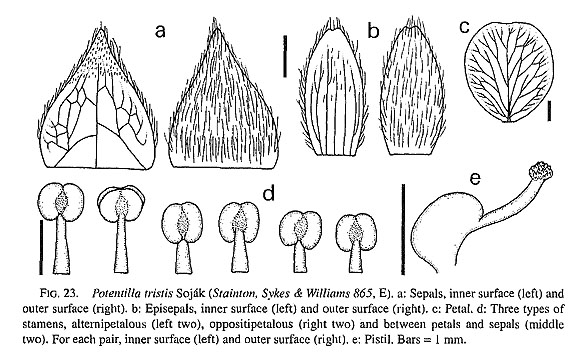
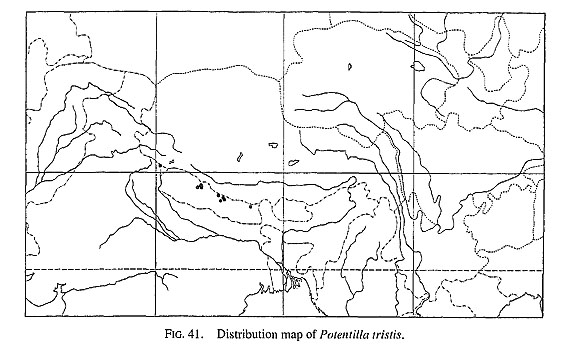
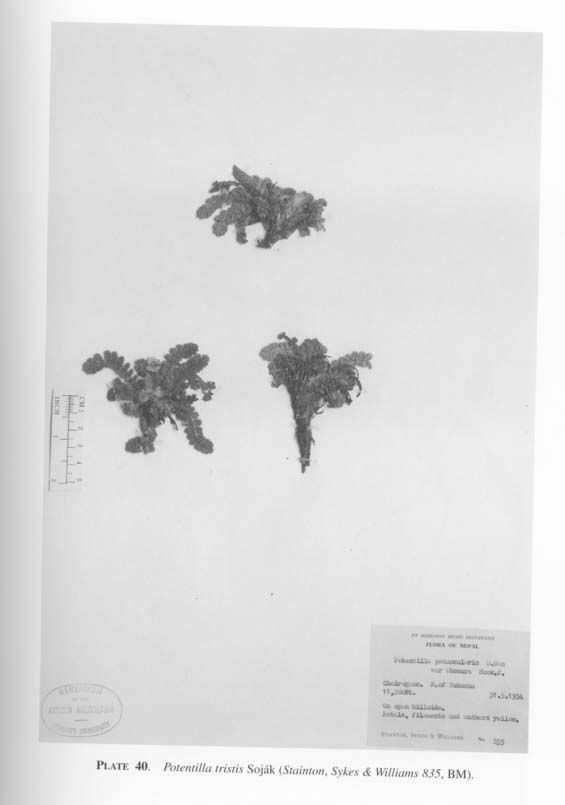
Types: Nepal; Tukucha, Kali Gandaki (Stainton, Sykes & Williams 7767, 11 Sept. 1954, BM-holotype, E-isotype).
SYNONYMS: P. peduncularis D. Don var. obscura Hook.f., Fl. Brit. Ind. 2: 352 (1878). Strachey, Cat. Pl. Kumaon 56 (1906). H. Leveillé, Cat. Pl. Yun-Nan 232 (1917). Wolf, Monogr. Potentilla 678 (1908).
Type: NW India; Kumaon, Kalari, 13000 ft. (Strachey & Winterbottom, K-holo-type).
P. fallens auct non Card.; Miehe, Langtang Himal 445 (1990).
Radical leaves oblanceolate, 2-7 cm long, 1.0-1.5 cm wide, lateral leaflets 8-13 pairs, usually with alternating smaller leaflets; petiole 0.5-1.0 cm long; base of uppermost pair of leaflets decurrent. Lower surface of leaflets with dense patent hairs, especially on veins; terminal leaflet sessile, oblong to obovate, 4-5 mm long, 4-5 mm wide, serrate, with 6-11 teeth. Auricles of stipules connate from base to middle.
Peduncles 2-4 cm long. Cauline leaves with 1 or 2 pairs of leaflets. Auricles of stipules serrate, with 2-4 teeth.
Pedicel ca. 5 mm long. Flowers 8-12 mm across; hypanthium 5-7 mm across. Episepals oblong to obovate, 2.0-3.5 mm long, 1.2-2.3 mm wide, entire or with 3 teeth, apex acute or obtuse, sparsely pubescent above, sericeous beneath. Sepals elliptic to ovate, 2.0-3.5 mm long, 1.5-3.0 mm wide, entire, apex acute or obtuse, puberu-lent toward apex above, sericeous beneath. Petals oblong to elliptic, apex rounded, 4.0-5.2 mm long, 4.0-4.5 mm wide.
Stamens 1.2-1.4 mm long; anthers globose to ellipsoid, 0.5-0.7 mm long, 0.4-0.7 mm wide. Ovaries ellipsoid, 0.6-0.8 mm long, 0.4-0.6 mm wide; styles 0.9-1.3 mm long, slender; stigmas slightly inflated.
Chromosome number 2n=28.
Distr. NW India and Nepal.
Potentilla tristis is similar to P. contigua and P. commutata in habit. The stipules of the radical leaves of P. tristis are connate from the base to the middle, while those of P. contigua are free with two lobes and those of P. commutata are wholly connate and form a membranaceous structure.
17. Potentilla commutata Lehm., Pugill. 3: 16 (1831); Rev. Potentilla. 65 (1856). Soják in Candollea 43: t. 1, f. 10; t. 2, f. 4 (1988). Miehe, Langtang Himal 445 (1990). Ikeda in Ohba and Akiyama, Alp. Fl. Jaljale Himal 34 (1992). Soják in Bot. Jahrb. Syst.ll6:35(1994).
Type: NW India; Kumaon (Wallich 1010δ, K-holotype)
SYNONYMS: P. microphylla D. Don var. commutata (Lehm.) Hook. f., Fl. Brit. Ind. 2: 353 (1878). Strachey, Cat. Pl. Kumaon 56 (1906). Handel-Mazzetti, Symb. Sin. 7: 519 (1933). Ohashi in Hara and Williams, Enum. Flow. Pl. Nepal 2: 141 (1979). Wu et al., Index Fl. Yunnan. 1: 497 (1984).
P. microphylla D. Don 6 (var.) latifolia Wall. [Cat. 28, n. 1010δ (1829), nom. nud.] ex Lehm., Pugill. 3: 16 (1831). Wolf, Monogr. Potentilla 683 (1908). Grierson and Long, Fl. Bhutan 1: 573 (1987), pro parte.
Type: NW India; Kumaon (Wallich 1010δ, K-lectotype, designated by Soják in 1989).
P. microphylla D.Don δ (var.) latiloba Lehm., Rev. Potentilla. 30 (1856).
Lehmann (1856) mistakenly cited δ latifolia as "δ latiloba".
P. glabriuscula (T.T. Yü et C.L. Li) Soják var. majuscula Soják in Bot. Jahrb. Syst. 116:41 (1994).
Type: Sikkim, Yamtung (Hooker s.n. in 1849, K-holotype).
Radical leaves oblanceolate, 2-8 cm long, 0.6-1.5 cm wide, lateral leaflets 5-15 pairs, without smaller leaflets; petiole 3-10 mm long; base of uppermost pair of leaflets decurrent. Leaflets strigose above, sericeous beneath; terminal leaflet sessile or subsessile, oblong to narrowly obovate, 3.5-8.0 mm long, 2.0-4.0 mm wide, serrate, with 7-12 teeth. Auricles of stipules connate, apex rounded.
Peduncles 0.5-5.0 cm long. Cauline leaves simple or with one pair of leaflets, entire or tri-lobed. Auricles of stipules entire or with 2 or 3 teeth.
Pedicel 0.3-2.5 cm long. Flowers 5-12 mm across; hypanthium 4-8 mm across. Episepals lanceolate to oblong, 1.5-2.5 mm long, 0.7-2.5 mm wide, entire or with 3 teeth, apex acute or obtuse, sparsely strigose above, sericeous beneath. Sepals elliptic to ovate, 1.5-2.5 mm long, 1.5-2.0 mm wide, entire, apex acute or obtuse, pubescent toward apex above, sericeous beneath. Petals oblong to elliptic, apex rounded, 3.0-4.5 mm long, 2.6-4.2 mm wide.
Stamens 10-14 (var. commutata) or around 20 (var. polyandra), 1.2-1.7 mm long; anthers globose to ellipsoid, 0.4-0.7 mm long, 0.4-0.7 mm wide. Ovaries ellipsoid, 0.5-0.8 mm long, 0.4-0.5 mm wide; styles 0.4-0.7 mm long, slender; stigmas slightly inflated.
Wallich (1829) used the name P. microphylla δ latifolia for his specimen no. 1010δ, but did not publish a description. Lehmann (1831) described P. commutata based on the same specimen and also validated P. microphylla δ latifolia at the same time using the same type. Hooker (1878) changed the status of P. commutata to P. microphylla var. commutata. In addition to the new combination, Hooker (1878) cited Royle's (1835) illustration of var. latiloba, which is identical with P. microphylla var. microphylla under P. microphylla var. commutata.
Potentilla commutata has relatively small petals and a large number of pistils.

17a. var. commutata [Figs. 24 & 42; Pls. 11 & 12]
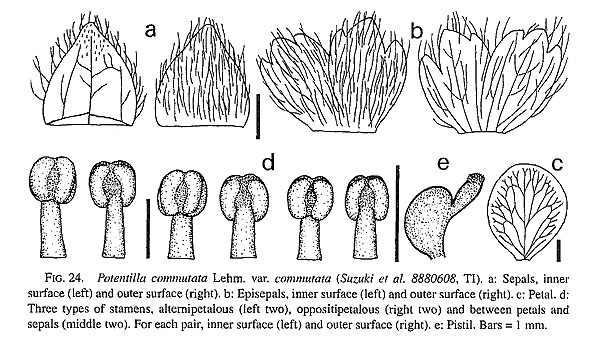
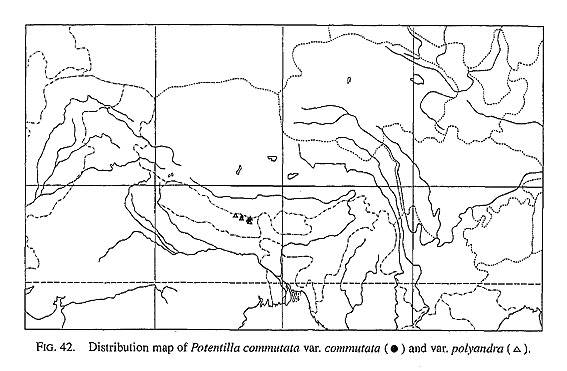
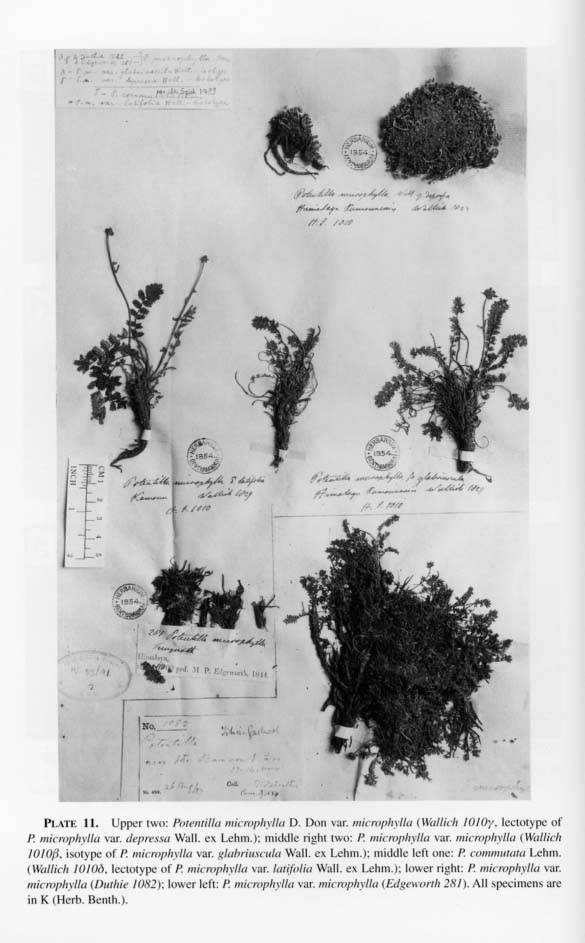

Radical leaves 2-4 cm long, 6-8 mm wide, lateral leaflets 5-9 pairs; petiole 3-5 mm long; terminal leaflet 3.5-5.0 mm long, 2-3 mm wide, with 7-12 teeth.
Peduncles 0.5-1.5 cm long; pedicel 3-7 mm long. Flowers 5-8 mm across; hypanthium 4-6 mm across. Episepals 1.5-2.5 mm long, 1.5-2.5 mm wide, with 3 teeth. Sepals 1.5-2.2 mm long, 1.5-2.0 mm wide. Petals 3.5-4.5 mm long, 3.0-4.2 mm wide.
Stamens 10-14,1.3-1.7 mm long; anthers 0.5-0.7 mm long, 0.5-0.7 mm wide. Ovaries 0.6-0.8 mm long, 0.4-0.5 mm wide; styles 0.4-0.5 mm long.
Chromosome number 2n=14.
Distr. NW India, Nepal, and Sikkim.
17b. var. polyandra Soják in Bot. Jahrb. Syst. 116: 38 (1994). [Figs. 25 & 42]
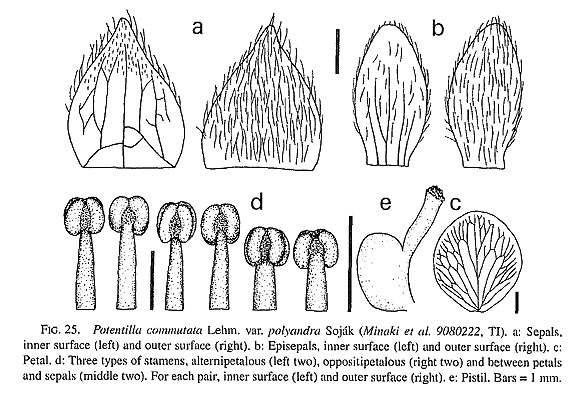
Type: Nepal; Lamjung Himal (Stainton, Sykes & Williams 6313 in 1954, BM-holo-type).
SYNONYMS: P. mieheorum Soják in Bot. Jahrb. Syst. 116: 38 (1994).
Type: Nepal, Surdscha Kunda, Alm Gatsche, 4260 m (G. & S. Miehe 8398 in 1986, PR-holotype).
R decemjuga Soják in Bot. Jahrb. Syst. 116: 43 (1994).
Types: Sichuan [Sikang], Kanting [Kangding], Tapaoshan, ca. 4500 m (H. Smith 11479 in 1934, W-holotype, WU-isotype).
Radical leaves 3-8 cm long, 1.0-1.5 cm wide, lateral leaflets 10-15 pairs; petiole 0.5-1.0 cm long; terminal leaflet 5-8 mm long, 3-4 mm wide, with 7-11 teeth.
Peduncles 2-5 cm long; pedicel 1.0-2.5 cm long. Flowers 8-12 mm across; hy-panthium 6-8 mm across. Episepals 1.5-2.0mm long, 0.7-1.0 mm wide. Sepals 2.0-2.5 mm long, 1.5-2.0 mm wide. Petals 3-4 mm long, 2.6-3.3 mm wide.
Stamens around 20, 1.2-1.4 mm long; anthers 0.4-0.5 mm long, 0.4-0.5 mm wide. Ovaries 0.5-0.6 mm long, 0.4-0.5 mm wide; styles 0.5-0.7 mm long.
Chromosome number 2n=14.
Distr. NW India, Nepal, Sikkim, and China (Sichuan).
In Nepal, var. commutata and var. polyandra often grow sympatrically.
iv. Series Leuconotae (Dixit et Panigrahi) H. Ikeda et H. Ohba, comb. nov.
BASIONYM: Section Leuconotae Dixit et Panigrahi in Proc. 4th Ann. Conf. Orissa Bot. Soc. 25 (1979).
Type species: Potentilla. leuconota D.Don
18. Potentilla leuconota D. Don, Prodr. Fl. Nepal. 230 (1825). Seringe in DC, Prodr. 2: 583 (1825). Lehm., Pugill 3: 12 (1831); Rev. Potentilla. 65 (1856). Hook. f., Fl. Brit. Ind. 2: 352 (1878). Franchet, Pl. Delavay. 2: 41 (1888); Pl. Delavay. 3: 213 (1890). Strachey, Cat. Pl. Kumaon 56 (1906). Wolf, Monogr. Potentilla 679 (1908), excl. var. borneensis. H. Leveillé in Cat. Pl. Yun-Nan 232 (1917). J. Krause in Repert. Spec. Nov. Regni Veg. Beih. 12: 410 (1922). Handel-Mazzetti, Symb. Sin. 7: 518 (1933). Fletcher in Notes Roy. Bot. Gard. Edinb. 20: 213 (1950). Murata in Hara, Fl. E. Himal. 123 (1966). Acad. Sin. Bot., Iconogr. Cormophyt. Sin. 2: 300, t. 2330 (1972). Malla et al. in Bull. Dept. Med. Pl. Nepal 7: 78 (1976). Ohashi in Hara and Williams, Enum. Flow. Pl. Nepal 2: 140 (1979). Wu et al., Index Fl. Yunnan. 1: 496 (1984). Yü and Li in Yü, Fl. Reipubl. Popul. Sin. 37: 266 (1985). Yü et al. in Wu, Fl. Xizang. 2: 648 (1985). Grierson and Long, Fl. Bhutan 1: 572 (1987). Soják in Candollea 43: t. 3, f. 9; t. 5, f. 3 (1988). Miehe, Langtang Himal 445 (1990). Ikeda in Ohba and Akiyama, Alp. Fl. Jaljale Himal 36 (1992). Ku in Wang et al., Vasc. Pl. Hengduan Mts. 1: 849 (1993).
Types: Nepal; Gosainthan (Wallich s.n., BM-holotype, isotype, K-isotype).
Radical leaves oblanceolate, 2.5-20 cm long, 1.0-4.0 cm wide, lateral leaflets 6-18 pairs, usually with alternating smaller leaflets; petiole 1-4 cm long; base of uppermost pair of leaflets decurrent. Lower surface of leaflets sericeous (vars. leuconota and omeiensis) or strigose (var. brachyphyllaria); terminal leaflet sessile, oblong to narrowly obovate, 0.5-2.0 cm long, 3-10 mm wide, serrate, with 10-25 teeth. Auricles of stipules connate from base to middle.
Peduncles 2-23 cm long. Cauline leaves with 3-10 pairs of leaflets. Auricles of stipules serrate, with 5-10 teeth.
Inflorescence umbel-like. Pedicel 0.2-3.0cm long. Flowers 5-8 mm across; hy
panthium 3-6 mm across. Episepals lanceolate to oblong, 1.5-2.0 mm long, 0.7-1.0 mm wide, entire, apex acute or obtuse, sparsely strigose above, sericeous beneath. Sepals elliptic to ovate, 2.0-2.5 mm long, 1.5-2.0 mm wide, entire, glabrous or puberulent toward apex above, sericeous beneath. Petals oblong to elliptic, apex rounded, 3.0-4.0 mm long, 2.6-3.3 mm wide.
Stamens 1.2-1.4 mm long; anthers globose to ellipsoid, 0.4-0.5 mm long, 0.4-0.5 mm wide. Ovaries ellipsoid, 0.5-0.6 mm long, 0.4-0.5 mm wide; styles 0.5-0.7 mm long, slender; stigmas slightly inflated.
Potentilla leuconota is characterized by its umbel-like inflorescence and by the auricles of the stipules of the radical leaves being connate from the base to the middle.

18a. var. leuconota [Figs. 26 (upper) & 43; Pl. 41]
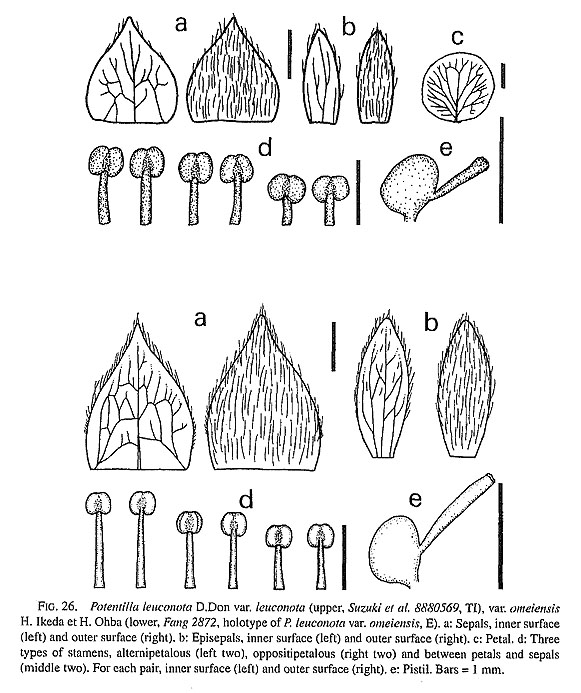
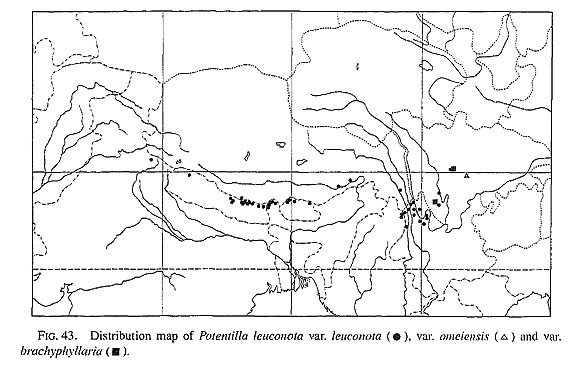
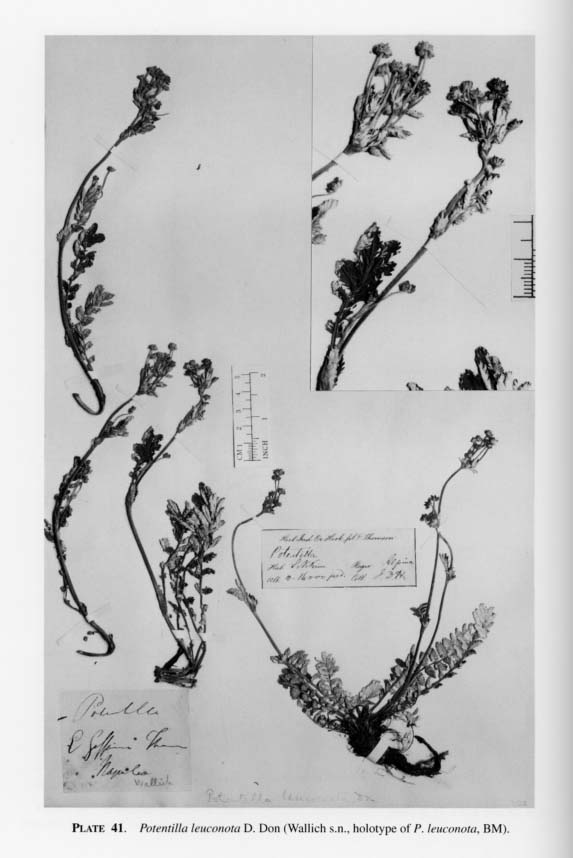
SYNONYMS: P. velutina Wall., Cat. 28. n. 1016 (1829), nom. nud.
P. leuconota D.Don var. morrisonicola Hayata in J. Coll. Sci. Univ. Tokyo 25(19): 83 (1908). Su in Li et al., Fl. Taiwan 3: 78 (1977).
Type: Taiwan ("Formosa"); Mt. Morrison, 13094 ft. (S. Nagasawa 732, Nov. 1905, TI-holotype).
P. morrisonicola (Hayata) Hayata, Icon. Pl. Form. 3: 96 (1913).
Radical leaves 2.5-20 cm long, 1.5-4.0 cm wide, lateral leaflets 6-17 pairs; petiole 1-3 cm long; terminal leaflet 0.5-2.0 cm long, 3-10 mm long, with 10-20 teeth.
Peduncles 2.0-2.5 cm long; pedicel 1-3 cm long. Flowers 5-8 mm across; hypanthium 3-5 mm across. Episepals 1.5-2.0 mm long, 0.7-1.0 mm wide. Sepals 2.0-2.5 mm long, 1.5-2.0 mm wide. Petals 3-4 mm long, 2.6-3.3 mm wide.
Stamens 1.2-1.4 mm long; anthers 0.4-0.5 mm long, 0.4-0.5 mm wide. Ovaries 0.5-0.6 mm long, 0.4-0.5 mm wide; styles 0.5-0.7 mm long.
Chromosome number 2n=l4.
Distr. NW India, Nepal, Sikkim, Bhutan, Assam, N Myanmar, and China (Yunnan, Sichuan, Xizang, Hubei, and Taiwan).
Variety leuconota is distributed widely from NW India to Taiwan. Although P. leuconota from Taiwan has been treated as a variety (var. morrisonicola) or distinct species (P. morrisonicola) because it lacks smaller leaflets between the regular pairs of leaflets and has small bracts on the petioles (Hayata 1908), these characters are not stable and it is difficult to distinguish them from other plants from further west.
18b. var. omeiensis H. Ikeda et H. Ohba, var. nov. [Figs. 26 (lower) & 43; Pl. 42]
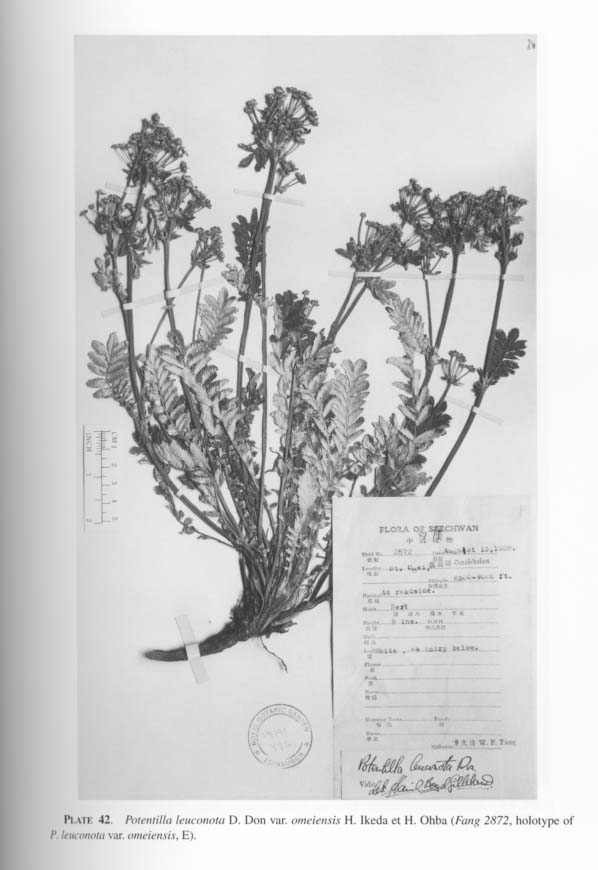
A typo foliis infra pilis aureis (nec argenteis) satis distincta.
Types: China; Sichuan, Omei Xian, Mt. Omei, 8500-9000 ft. (Fang 2872, 13 Aug. 1928, E-holotype, A, US-isotypes).
Radical leaves 12-18 cm long, 2-3 cm wide, lateral leaflets 15-18 pairs; petiole 3-4 cm long; terminal leaflet 12-20 mm long, 5-8 mm wide, with 20-25 teeth.
Peduncles 14-23 cm long; pedicel 1-2 cm long. Flowers 6-8 mm across; hypanthium 4-6 mm across. Episepals 1.5-2.0 mm long, 0.7-1.0 mm wide. Sepals 2.0-2.5 mm long, 1.5-2.0 mm wide. Petals 3.0-4.0 mm long, 2.6-3.3 mm wide.
Stamens 1.2-1.4 mm long; anthers 0.4-0.5 mm long, 0.4-0.5 mm wide. Ovaries 0.5-0.6 mm long, 0.4-0.5 mm wide; styles 0.5-0.7 mm long.
Distr. China (Sichuan).
Variety omeiensis has golden hairs on both surfaces of the leaves, and on the rachis, petioles and peduncles; var. leuconota has silvery hairs. Variety omeiensis is known only from Mt. Omei, Sichuan.
18c. var. brachyphyllaria Card. in Lecomte, Not. Syst. 3: 241 (1914). Handel-Mazzetti in Acta Hort. Gothob. 13: 324 (1939). Wu et al., Index Fl. Yunnan. 1: 496 (1984). Ku in Wang et al., Vase. Pl. Hengduan Mts. 1: 849 (1993).
[Figs. 27 & 43; Pl. 43]

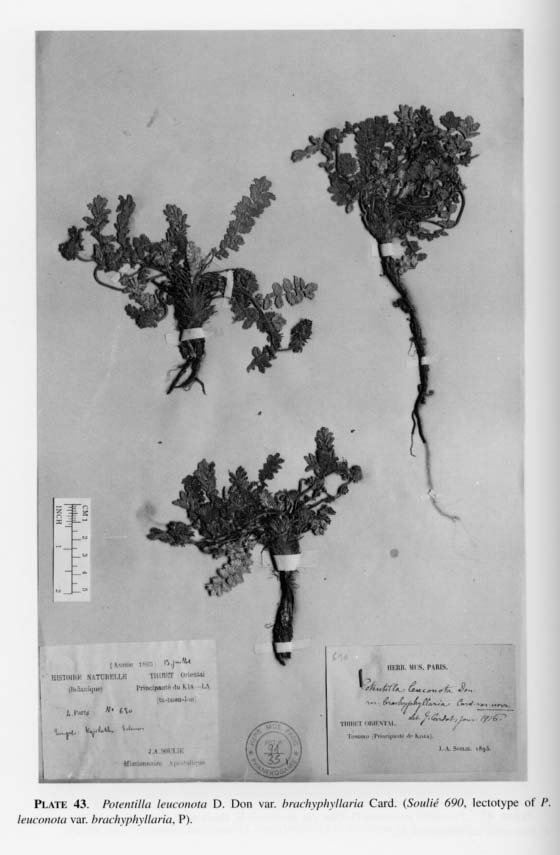
Types: China; Szechuan, Kiala, Tongolo (Soulié 690, 13 July 1893, P-lectotype, designated here). China; Szechuan, Kiala, Ta-tsien-lou [Kangding] (Soulié s.n. in 1893, P-syntype). Tibet orient.; Kajilatho (Soulié 2447, 20 July 1894, P, BM-syntypes).
Radical leaves 4-9 cm long, 1.0-2.5 cm wide, lateral leaflets 8-15 pairs; terminal leaflet 6-10 mm long, 4-6 mm wide.
Peduncles 5-8 cm long; pedicel 1-2 mm long. Flowers 5-7 mm across; hypanthium 3-5 mm across. Episepals 1.5-2.0 mm long, 0.7-1.0 mm wide. Sepals 2.0-2.5 mm long, 1.5-2.0 mm wide. Petals 3-4 mm long, 2.6-3.3 mm wide.
Stamens 1.2-1.4 mm long; anthers 0.4-0.5 mm long, 0.4-0.5 mm wide. Ovaries 0.5-0.6 mm long, 0.4-0.5 mm wide; styles 0.5-0.7 mm long.
Distr. Assam and China (Yunnan, Sichuan, and Xizang).
Variety brachyphyllaria has leaves with relatively few hairs on both surfaces of the leaflets.
19. Potentilla montisvictoriae H. Ikeda et H. Ohba in Edinb. J. Bot. 52: 225 (1995).
[Fig. 44; Pl. 44]
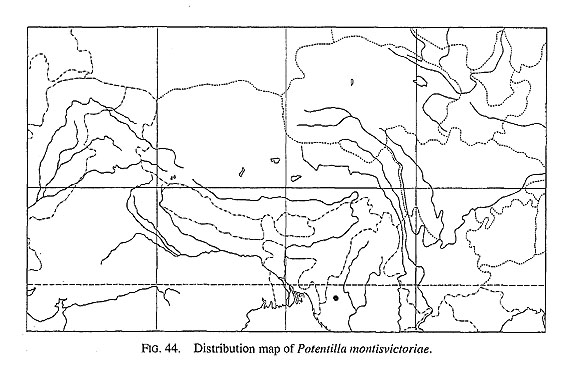
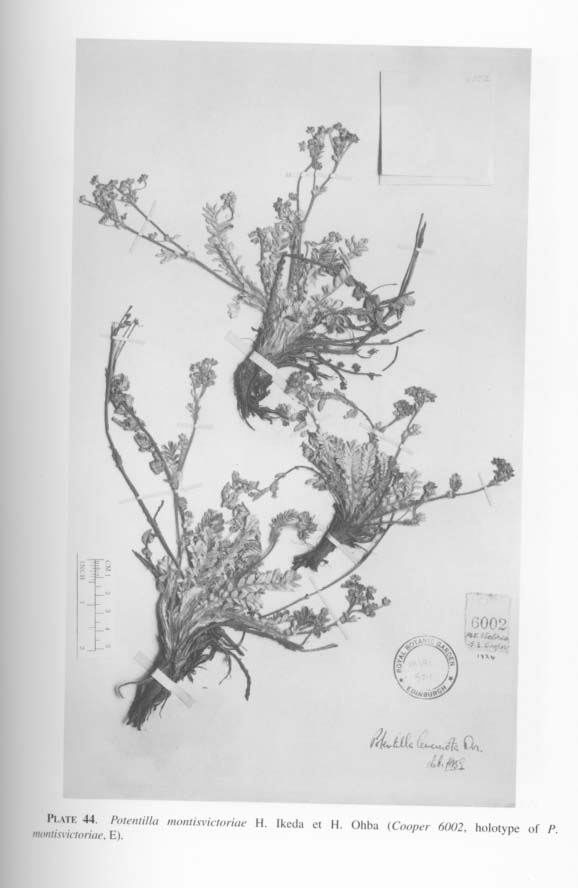
Types: C Myanmar; Mt. Victoria (Cooper 6002 in 1924, E-holotype and isotype).
Radical leaves oblanceolate, 4-12 cm long, 1-5 cm wide, lateral leaflets 6-12 pairs, usually with alternating smaller leaflets; petiole 1-3 cm long; base of uppermost pair of leaflets decurrent. Leaflets sericeous beneath; terminal leaflet sessile, oblong to nar-rowly obovate, 5-8 mm long, 3-4 mm wide, serrate, with 10-15 teeth. Auricles of stipules free.
Peduncles 5-10 cm long. Cauline leaves with 3-7 pairs of leaflets. Auricles of stipules entire or with 2 or 3 teeth.
Pedicel 5-15 cm long. Flowers 8-12 mm across; hypanthium 4-8 mm across. Episepals lanceolate to narrowly elliptic, 1.5-2.0 mm long, 0.7-1.0 mm wide, entire, apex acute or obtuse, sparsely strigose above, sericeous beneath. Sepals elliptic to ovate, 2.0-2.5 mm long, 1.5-2.0 mm wide, entire, apex acute or obtuse, puberulent toward apex above, sericeous beneath. Petals obovate, apex rounded, 3.0-4.0 mm long, 2.6-3.3 mm wide.
Stamens 1.2-1.4 mm long; anthers globose to ellipsoid, 0.4-0.5 mm long, 0.4-0.5 mm wide. Ovaries ellipsoid, 0.5-0.6 mm long, 0.4-0.5 mm wide; styles 0.5-0.7 mm long, slender; stigmas slightly inflated.
Distr. C Myanmar (Mt. Victoria).
Although P. montisvictoriae has been confused with P. leuconota, it differs in having the auricles of the stipules of the radical leaves free; in P. leuconota the auricles of the stipules are connate from the base to the middle. Potentilla montisvictoriae is known only from Mt, Victoria, C Myanmar.
20. Potentilla wenchuensis H. Ikeda et H. Ohba, sp. nov. [Figs. 28 & 45; Pl. 45]
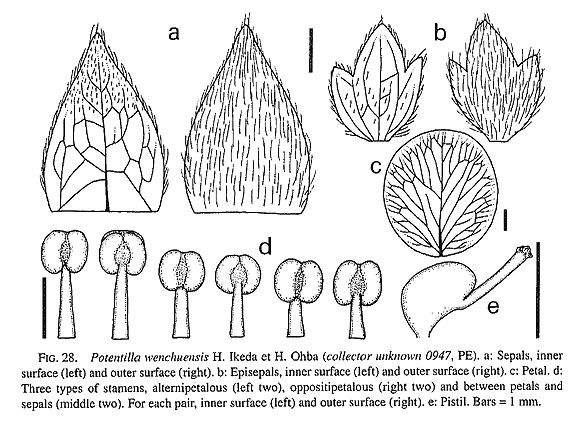
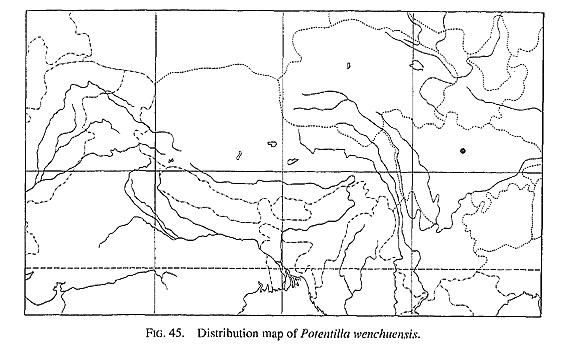
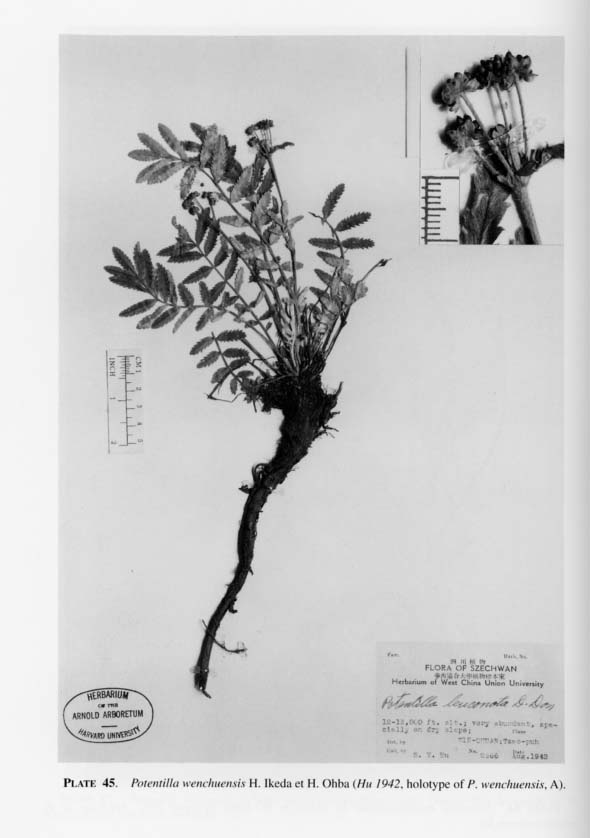
Potentillae leuconotae D. Don primo adspectu maxime similis, sed auriculis stipularum foliorum cauliferorum integris nec bilobatis.
Type: China; Sichuan, Wen-chuan, Tsao-puh, 12000-13000 ft. (S. Y. Hu 2666, Aug. 1942,A-holotype).
Radical leaves oblanceolate, 10-18 cm long, 3-4 cm wide, lateral leaflets 8-10 pairs, without smaller leaflets; petiole 2-4 cm long; base of uppermost pair of leaflets decurrent. Leaflets yellowish silvery beneath; terminal leaflet sessile, lanceolate to narrowly oblong, 5-7 mm long, ca. 2 mm wide, serrate, with ca. 20 teeth. Auricles of stipules connate, apex rounded.
Peduncles 9-12 cm long. Cauline leaves with 1 or 2 pairs of leaflets. Auricles of stipules serrate, with 4-6 teeth.
Pedicel 1.0-1.5 cm long. Hypanthium 5-7 mm across. Episepals oblong to obovate, 1.5-2.0 mm long, 0.7-1.0 mm wide, entire, apex acute or obtuse, sparsely strigose above, sericeous beneath. Sepals elliptic to ovate, 2.0-2.5 mm long, 1.5-2.0 mm wide, entire, apex acute or obtuse, puberulent toward apex above, sericeous beneath. Petals oblong to elliptic, apex rounded, 3.0-4.0 mm long, 2.6-3.3 mm wide.
Distr. China (Sichuan and Guizhou).
Potentilla wenchuensis is similar to P. leuconota in its umbel-like inflorescence. The stipules of the radical leaves of P. wenchuensis have one membranaceous auricle; the auricles of P. leuconota are connate from the base to the middle. Potentilla wenchuensis occurs in Sichuan and Guizhou, China.
B. Subsection Leptostylae
v. Series Leptostylae
SYNONYMS: Grex Anserinae Th. Wolf, Monogr. Potentilla 667 (1908).
Ser. Anserinae (Th.Wolf) T.T. Yü et C.L. Li in Acta Phytotax. Sin. 18: 5 (1980); in Yü, Fl. Reipubl. Popul. Sin. 37: 275 (1985).
21. Potentilla anserina L., Sp. Pl. 495 (1753). Lehm., Monogr. Potentilla. 71 (1820). Seringe in DC., Prodr. 2: 582 (1825). Bunge, Enum. Pl. Chin. Bor. 26 (1833). Lehm., Rev. Potentilla. 188 (1856). Hook. f., Fl. Brit. Ind. 2: 350 (1878). Franchet, Pl, David. 1: 113 (1884); Pl. Delavay. 3: 211 (1890). Strachey, Cat. Pl. Kumaon 56 (1906). Wolf, Monogr. Potentilla 669 (1908). H. Léveillé in Cat. Pl. Yun-Nan 232 (1917). Melchior and Stroh in Notizb. Bot. Gart. Mus. Berl.-Dahlem 11: 799 (1933). Handel-Mazzetti in Acta Hort. Gothob. 13: 326 (1939). Fletcher in Notes Roy. Bot. Gard. Edinb. 20: 207 (1950). Baehni, Bonner and Vautier in Candollea 13: 228 (1951). Kitamura in Kihara, Fauna Fl. Nepal Himal. 149 (1955). Kitamura, Pl. W. Pakist. 84 (1964). Murata in Hara, Fl. E. Himal. 2: 52 (1971). Pesmen in Davis, Fl. Turkey 4: 47 (1972). Nasir and Ali in Fl. W. Pakistan 353 (1972). Acad. Sin. Bot., Iconogr. Cormophyt. Sin. 2: 300, t. 2329 (1972). Acad. Sin. Bot., Fl. Tsinling. 1(2): 549, t. 458 (1974). Malla et al. in Bull. Dept. Med. Pl. Nepal 7: 78 (1976). Ohashi in Hara and Williams, Enum. Flow. Pl. Nepal 2: 138 (1979). Panigrahi and Dixit in J. Econ. Tax. Bot. 1: 129 (1980). Polunin and Stainton, Flow. Himal. 125 (1984). Wu et al., Index Fl. Yunnan. 1: 490 (1984). Yü and Li in Yü, Fl. Reipubl. Popul. Sin. 37: 275 (1985). Yü et al. in Wu, Fl. Xizang. 2: 652 (1985). Grierson and Long, Fl. Bhutan 1: 571 (1987). Miehe, Langtang Himal 445 (1990). Ikeda in Ohba and Akiyama, Alp. Fl. Jaljale Himal 34 (1992). Ku in Wang et al.. Vase. Pl. Hengduan Mts. 1: 850 (1993). [Figs. 29 & 46]
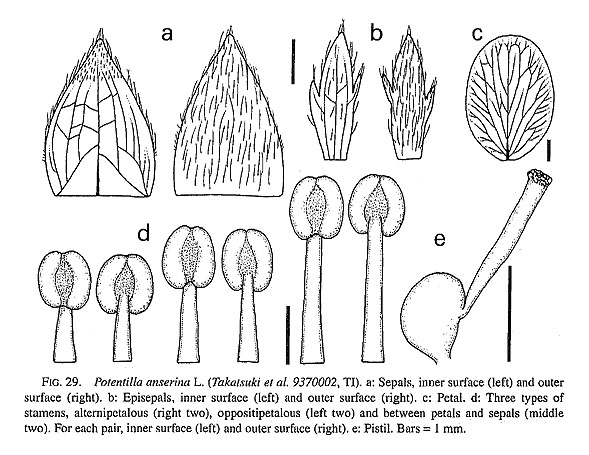
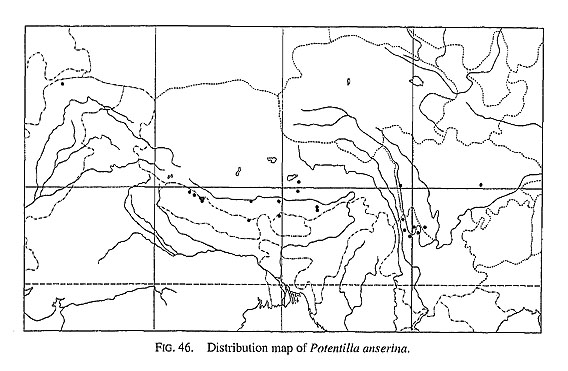
Type: Linnaeus in the Clifford Herbarium (BM), lectotypified by Rousi (1965).
SYNONYMS: P. anserina L. var. sericea Hayne, Arzneneigew 4: 31 (1816). Yü et Li in Yü, Fl. Reipubl, Popul. Sin. 37: 276 (1985). Ku in Wang et al., Vase. Pl. Hengduan Mts. 1: 850(1993).
P. anserina L. forma suberosa Th.Wolf, Monogr. Potentilla 671 (1908).
P. anserina L. var. orientalis Card. in Lecomte, Not. Syst. 3: 240 (1914).
Stoloniferous herbs. Radical leaves oblanceolate, 3-12 cm long, 1.5-3.0 cm wide, lateral leaflets 5-10 pairs, with alternating smaller leaflets; petiole 1-2 cm long; base of uppermost pair of leaflets cuneate or slightly decurrent. Leaflets sericeous beneath; terminal leaflet petiolate or subsessile, oblong to narrowly obovate, 0.5-1.2 cm long, 0.4-1.0 cm wide, serrate, 13-19 teeth. Auricles of stipules connate, apex rounded.
Flowers solitary, borne in axils of radical leaves and leaves of stolons. Pedicel without leaves or bracts, 2-5 cm long, glabrous. Flowers 1.5-2.5 cm across; hy-panthium 0.3-0.5 mm across. Episepals oblong to obovate, 3.0-8.0 mm long, 1.0-4.0 mm wide, entire or with 2-4 teeth, apex acute or obtuse, sparsely hairy above, sericeous beneath. Sepals elliptic to ovate, 3.0-8.0 mm long, 2.0-5.0 mm wide, entire, apex acute or obtuse, puberulent toward apex above, sericeous beneath.
Petals oblong to elliptic, apex rounded, 5.0-12.0 mm long, 3.0-7.0 mm wide.
Stamens 3.0-5.0 mm long; anthers globose to ellipsoid, 0.8-1.2 mm long, 0.4-0.8 mm wide. Ovaries ellipsoid, 0.8-1.2 mm long, 0.4-0.8 mm wide; styles 2.0-4.0 mm long, slender; stigmas slightly inflated.
Chromosome number of Nepalese plants 2n=28.
Distr. NW India, Nepal, Sikkim, Bhutan, China; temperate regions, seacoasts and mountainous regions of Europe, Asia, America and New Zealand.
Potentilla anserina is distributed widely in the northern hemisphere (Europe, Asia, and America) and is also in the southern hemisphere (Chile and New Zealand). Rousi (1965) revised the P. anserina aggregate and recognized three subspecies in P. anserina, i.e., subspecies anserina, egedii (Wormsk.) Hiit. and pacifica (Howell) Rousi and one additional species, P. anserinoides Raoul. She treated the Himalayan P. anserina as subsp. anserina.
Potentilla anserina produces new shoots and flowers from the same nodes of the stolons.
22. Potentilla gombalana Hand.-Mazz. in Acta Hort. Gothob. 13: 324 (1939). Yü and Li in Yü. Fl. Reipubl. Popul. Sin. 37: 277 (1985). Ku in Wang et al.. Vase. Pl. Hengduan Mts. 1: 851 (1993). [Figs. 30 & 47; Pl. 46]
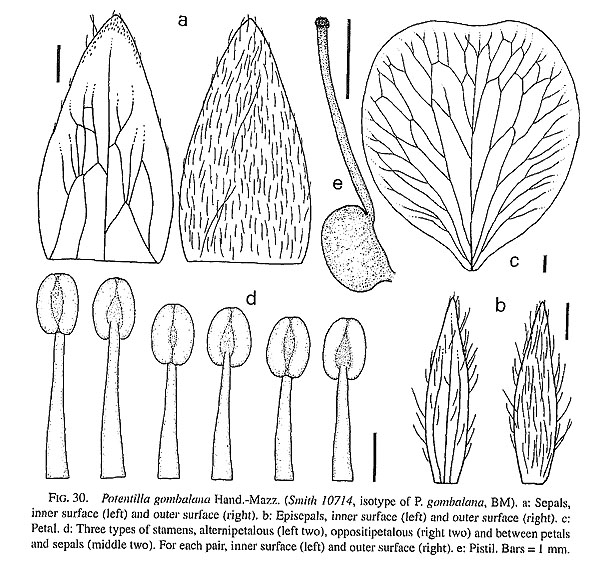
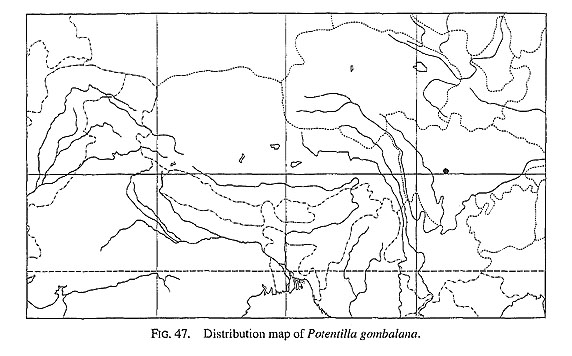

Types: China; Szechuan, Kangding (Tachienlu) distr., Yulingkong, Gomba La, c. 3700 m (Smith 10714, 22 July 1934, W-holotype, not seen, BM, PE-isotypes).
Stoloniferous herbs. Radical leaves oblanceolate, 13-25 cm long, 4.5-6.0 cm wide, lateral leaflets 9-12 pairs, with alternating smaller leaflets; petiole 2-4 cm long; base of uppermost pair of leaflets decurrent. Leaflets sericeous beneath; terminal leaflet sessile, narrowly oblong, 1.5-2.5 cm long, 8-10 mm wide, serrate, with 20-25 teeth. Auricles of stipules connate, apex rounded.
Flowers 1 or 2, borne in axils of radical leaves. Peduncles 6-15 cm long. Cauline leaves simple or with one pair of leaflets. Auricles of stipules entire or serrate, with 2-3 teeth.
Pedicel 4-5 cm long. Flowers 1.5-2.0 cm across; hypanthium 12-14 mm across. Episepals oblong to obovate, 3.0-5.0 mm long, 1.5-3.0 mm wide, entire or with 3 teeth, apex acute or obtuse, sparsely strigose above, sericeous beneath. Sepals elliptic to ovate, 4.0-6.0 mm long, 2.5-4.5 mm wide, entire, apex acute or obtuse, puberulent toward apex above, sericeous beneath. Petals oblong to elliptic, apex rounded, 5.0- 7.0 mm long, 4.0-5.5 mm wide.
Stamens 1.5-2.0 mm long; anthers globose to ellipsoid, 0.6-1.0 mm long, 0.4-0.9 mm wide. Ovaries ellipsoid, 0.6-0.8 mm long, 0.5-0,7 mm wide; styles ca. 2 mm long, slender; stigmas slightly inflated.
Distr. China (Sichuan).
Potentilla gombalana is characterized by the stolons arising from the axils of radical leaves. In the original description, the flowers of P. gombalana were reported to be borne in the axils of the radical leaves and on the stolons; the isotypes at BM and PE have flowers only from the radical leaves, not on the stolons.
Potentilla gombalana occurs in Sichuan (China).
vi. Series Smithianae H. Ikeda et H. Ohba, ser. nov.
Surcula flore terminata, ex axilla folii supremi oriens.
The sympodial branching pattern of the flowering stem of Ser. Smithianae is unique in section Leptostylae.
Potentilla smithiana and P. taronensis have axillary shoots terminating in a flower and bearing a new vegetative shoot from the axils of the uppermost leaf. After producing several flowering shoots the axillary shoot finally produces a new individual.
23. Potentilla smithiana Hand.-Mazz. in Acta Hort. Gothob. 13: 325 (1939). Yü and Li in Yü, Fl. Reipubl. Popul. Sin. 37: 277, t. 42, f. 4 & 5 (1985). [Fig. 48; Pl. 47]
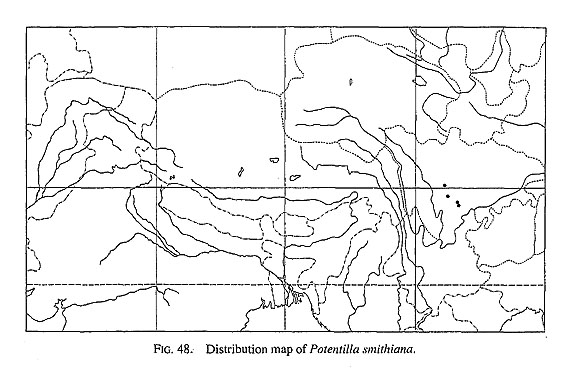
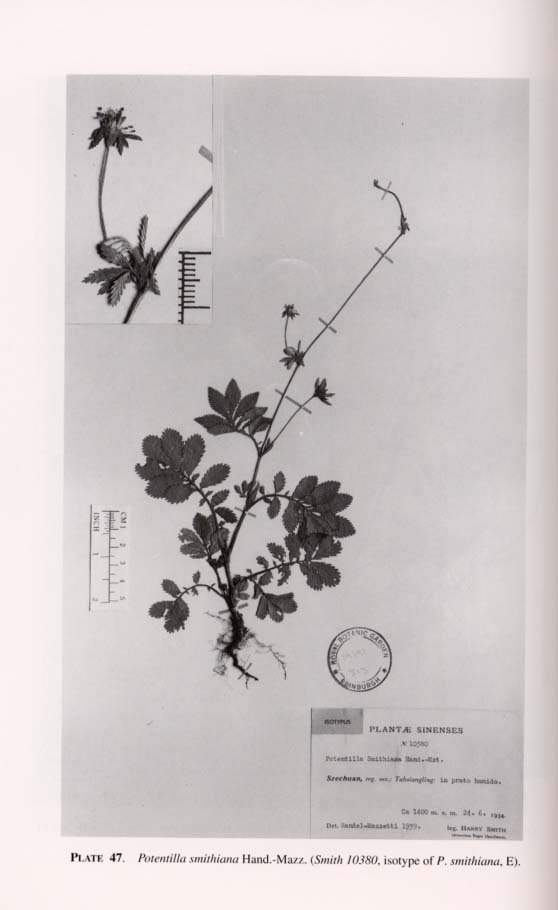
Types: China; Sichuan occid., Ta-hsiang-ling, c. 1400m (H. Smith 10380, 24 June 1934, W-holotype, not seen, A, BM, E, NY, PE-isotypes).
Stoloniferous herbs. No or few radical leaves at flowering time. Leaves on stolons oblong, 5-10 cm long, 2.5-5.5 cm wide, lateral leaflets 3-5 pairs, with alternating smaller leaflets; petiole 1.0-3.5 cm long; base of uppermost pair of leaflets cuneate or slightly decurrent. Leaflets strigose beneath; terminal leaflet subsessile, oblong to obo-vate, 1.5-3.5 cm long, 1.0-1.5 cm wide, serrate, with 16-30 teeth. Auricles of stipules free.
Flowers solitary and terminal. Pedicels 2-5 cm long. Hypanthium 1.0-1.2 cm across. Episepals narrowly oblong to oblong, 4-8 mm long, 1.5-3.0 mm wide, entire or with 3-5 teeth, apex acute or obtuse, sparsely strigose on both surfaces. Sepals elliptic to ovate, 4.0-5.0 mm long, 2.5-4.5 mm wide, entire, apex acute or obtuse, puberulent toward apex above, lower surface and margin strigose. Petals oblong to elliptic, apex rounded, 5.0-7.0 mm long, 4.0-5.5 mm wide.
Stamens 1.5-2.0 mm long; anthers ellipsoid, 0.6-0.8 mm long, 0.4-0.7 mm wide. Ovaries ellipsoid, 0.5-0.6 mm long, 0.3-0.4 mm wide; styles 2.5-3.0 mm long, slender; stigmas slightly inflated.
Distr. China (Sichuan).
24. Potentilla taronensis C.Y. Wu ex T.T. Yü et C.L. Li in Acta Phytotax. Sin. 18: 9, t. 2, f. 4 (1980). Wu et al.. Index Fl. Yunnan. 1: 499 (1984). Yü and Li in Yü, Fl. Reipubl. Popul. Sin. 37: 279, t. 42, f. 1-3 (1985). Ku in Wang et al., Vasc. Pl. Hengduan Mts. 1: 851 (1993). [Fig. 49; Pl. 48]
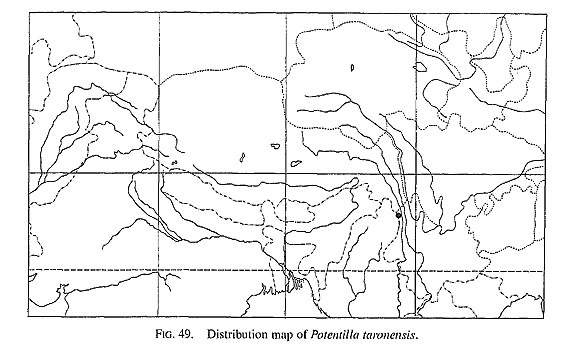
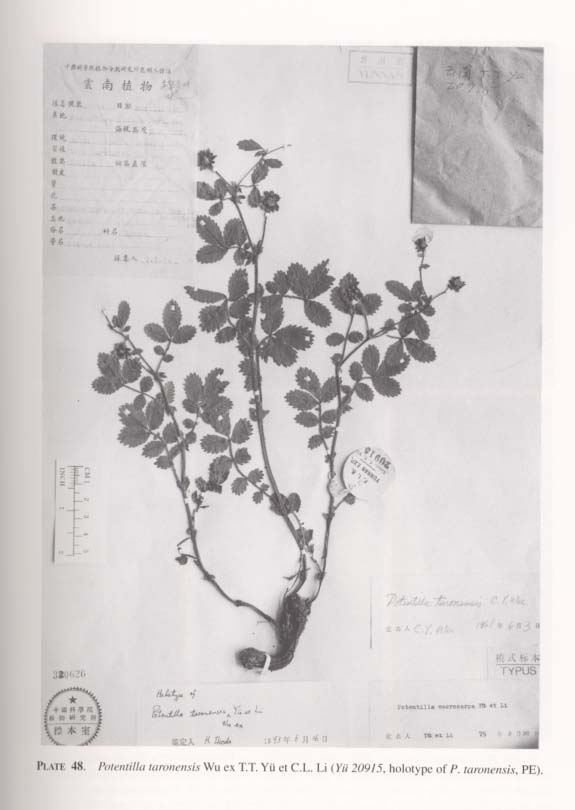
Types: China; Yunnan, Taron-Taru Divide, Tarulaka, Gonshan, 3000-3200 m (Yü 20915, 1 Nov. 1938, PE-holotype, KUN-isotype).
SYNONYM: P. macrocarpa T.T. Yü et C.L. Li, nom. nud., in shed.
Stoloniferous herbs. No or few radical leaves at flowering time. Leaves on stolons oblong, 5-10 cm long, 2.5-5.5 cm wide, lateral leaflets 3-5 pairs, with alternating smaller leaflets; petiole 1-3.5 cm long; base of uppermost pair of leaflets cuneate or slightly decurrent. Leaflets strigose beneath; terminal leaflet subsessile, oblong to obovate, 1.5-3.5 cm long, 1.0-1.5 cm wide, serrate, 16-30 teeth. Auricles of stipules free.
Flowers solitary and terminal, borne on stolons. Pedicel 2-5 cm long. Hypanthium 1.0-1.2 cm across. Episepals oblong to obovate, 3.0-5.0 mm long, 1.5-3.0 mm wide, entire or with 3-4 teeth, apex acute or obtuse, sparsely strigose on both surfaces. Sepals elliptic to ovate, 4.0-6.0 mm long, 2.5-4.5 mm wide, entire, apex acute or obtuse, puberulent toward apex above, lower surface and margin strigose.
Distr. China (Yunnan).
Potentilla taronensis is similar to P. smithiana, but differs in the shape and the hairiness of the leaflets. Potentilla taronensis has rhomboid-elliptic, sericeous leaflets; P. smithiana has elliptic, nearly glabrous leaflets.
The type specimens of P. taronensis at PE and KUN bear only fruits and have no flowers. No other specimens are known.
Natural Hybrids
Natural hybrids of sect. Leptostylae from Nepal were reported and described in Ikeda and Ohba(1993a, 1993b).
Potentilla × microcontigua H. Ikeda et H. Ohba in J. Jap. Bot. 68: 35 (1993a). (= P. contigua Soják × P. microphylla D. Don)
Potentilla × polyjosephiana H. Ikeda et H. Ohba in Bot. J. Linn. Soc. 112: 183 (1993b). (= P. josephiana H. Ikeda et H. Ohba × P. polyphylla Wall. ex Lehm.)
Potentilla festiva Soják × P. lineata Trev., Ikeda and Ohba in Bot. J. Linn. Soc. 112: 184 (1993b).
Potentilla lineata Trev. × P. polyphylla Wall. ex Lehm., Ikeda and Ohba in Bot. J. Linn.Soc.112: 185 (1993b).
Potentilla festiva Soják × P. polyphylla Wall. ex Lehm., Ikeda and Ohba in Bot. J. Linn. Soc. 112: 185 (1993b).
Summary
Potentilla L. section Leptostylae (Rosaceae) in Himalaya, China and Myanmar is revised. Twenty four species and 17 varieties are recognized. Two new species, P. turfosoides H. Ikeda et H. Ohba; and P. wenchuensis H. Ikeda et H. Ohba, and two new varieties, P. cardotiana Hand.-Mazz. var. nepalensis H. Ikeda et H. Ohba; and P. leuconota D. Don var. omeiensis H. Ikeda et H. Ohba are described. Eight new combinations and changes in status are proposed: P. microphylla D. Don vars. tapetodes (Soják) H. Ikeda et H. Ohba and luteopilosa (T.T. Yü et C.L, Li) H. Ikeda et H. Ohba; P. stenophylla (Franch.) Diels vars. taliensis (W.W. Smith) H. Ikeda et H. Ohba and cristata (Fletcher) H. Ikeda et H. Ohba; P. turfosa Hand.-Mazz. var. gracilescens (Soják) H. Ikeda et H. Ohba; P. peduncularis D. Don vars. vittata (Soják) H. Ikeda et H. Ohba, curta (Soják) H. Ikeda et H. Ohba and shweliensis (Fletcher) H. Ikeda et H. Ohba. Chromosome numbers of 16 species were counted and revealed a polyploid series in sect. Leptostylae.
Acknowledgement
We are especially grateful to Professor K. Iwatsuki, Rikkyo University, for his suggestions and facilities. Thanks are also due to Drs. M. Kato, J. Murata, N. Murakami, M. Hasebe, and S. Akiyama, for their criticism and suggestions. We are greatly indebted Dr. D. Boufford, Harvard University, for his critical reading and for correcting the English of the manuscript.
We express our thanks to Dr. M. Suzuki, Tohoku University, Dr. M. Minaki, University of Marketing and Distribution Sciences, and also Drs. S. B. Malla and S. B. Rajbhandary, former Directors General of the Department of Plant Resources, Nepal, for making their facilities available for our field studies in Nepal.
We thank Dr. N. Naruhashi and Mr. Y. Iwatsubo, Toyama University and Dr. H. Uchiyama, Nihon University for their technical help in the cytological observations. We are also obliged to acknowledge our colleagues at the University Museum, University of Tokyo, at the Museum of Nature and Human Activities, Hyogo, and at the Faculty of Informatics, Okayama University of Science for their help and encouragement.
We appreciate the cooperation of the directors and curators of the following herbaria who loaned specimens and/or provided facilities for my study: A, B, BM, CAL, DR, E, K, KATH, KUN, KYO, L, NY, P, PE, TI, TNS and US.
References
- Cardot, J. 1914.
- Rosacées Nouvelles d'Extrene-Orient. Lecomte, Not. Syst. 3: 230-243.
- Diels, L. 1912a.
- Plantae Chinenses Forrestianae. New and imperfectly known species. Notes Roy. Bot. Gard. Edinb. 5: 161-308.
- ———, L. 1912b.
- Plantae Chinenses Forrestianae. Notes Roy. Bot. Gard. Edinb. 7: 1-411.
- Don, D. 1825.
- Rosaceae. In: Prodromus Florae Nepalensis, 229-233. J. Gale, London.
- Eriandsson, S. 1942.
- Cytological studies in Potentilla anserina L. and closely allied Scandinavian species. Hereditas 28: 503-504.
- Fletcher, H. R. 1950.
- Potentillae et Sibbaldiae Forrestianae et Rockianae in Herbario Horti Regii Botanici Edinburgensis. Notes Roy. Bot. Gard. Edinb. 20: 207-218.
- Franchet, A. R. 1890.
- Plantae Delavayanae, 214. Paul Klincksieck, Paris.
- Gadella, T. W. J. and E. Kliphuis 1963.
- Chromosome numbers of flowering plants in the Netherlands. Acta Bot. Neerl. 12: 195-230.
- Grierson, A. J. C. and D. G. Long 1987.
- Potentilla L. In: Flora of Bhutan 1: 561-573. Royal Botanic Garden, Edinburgh.
- Handel-Mazzetti. H. 1933.
- Potentilla. In: Symbolae Sinicae 7: 508-519. Verlag von Julius Springer, Wien.
- Handel-Mazzetti, H. 1939.
- Plantae Sinenses. XXXVII, Rosaceae. 1: Potentillinae. Acta Hort. Gotob.13:289-334.
- Hayata, B. 1908.
- Flora montana Formosae. J. Coll. Sci. Univ. Tokyo 25(19); 1-260, with 41 plates.
- Holmgren, P. K., N. H. Holmgren and L. C. Barnet 1990.
- Index Herbariorum. Part 1: The herbaria of the world. New York Botanical Garden, New York.
- Hooker, J. D. 1878.
- Flora of British India 2: 345-360. L. Reeve & Co., London.
- Ikeda, H. 1989.
- Chromosome numbers of the Himalayan Potentilla (Rosaceae). J. Jap. Bot. 64: 361-367.
- Ikeda, H. and H. Ohba 1992.
- Taxonomic studies of Himalayan Potentilla (Rosaceae). I. P. makaluensis, a new species in sect. Leptostylae. J. Jap. Bot. 67: 148-153.
- ———. 1993a.
- Taxonomic studies of Himalayan Potentilla (Rosaceae). II. A new hybrid in sect. Leptostylae. J. Jap. Bot. 68: 32-37.
- ———. 1993b.
- A systematic revision of Potentilla lineata and allied species (Rosaceae) in the Himalaya and adjacent regions. Bot. J. Linn. Soc. 112: 159-186.
- Jørgensen, C. A., Th. Sørensen and M. Westergaard 1958.
- The flowering plants of Greenland. A taxonomical and cytological survey. Biol. Skr. Dan. Vid. Selsk, 9: 1-172.
- Kalkman, C. 1968.
- Potentilla, Duchesnea, and Fragaria in Malesia (Rosaceae). Blumea 16: 325-354.
- Ku, T. C. 1993.
- Potentilla L. In: Wang, W. T., S. G. Wu, K. Y. Lang, P. Q. Li, F. T. Pu and S. K. Chen (eds.), Vascular plants of the Hengduan mountains 1: 840-856. Science Press, Beijing.
- Lehmann, C. 1831.
- Novarum et minus cognitarum stirpium pugillus 3: 3-38. Hamburg.
- ———. 1856.
- Revisio Potentillarum. 1-230, with 64 figures. Breslau and Bonn, Germany.
- Löve, A. and D. Löve 1956.
- Cytotaxonomical conspectus of the Icelandic flora. Acta Hort. Gotob. 20: 65-290.
- Mabberly, D. J. 1987.
- The plant-book. Cambridge University Press, Cambridge.
- Ohashi, H. 1979.
- Potentilla L. In: Hara, H. and L. H. J. Williams (eds.), An enumeration of the flowering plants of Nepal. 2: 138-141, British Museum (Natural History), London.
- Pólya, L. 1949.
- Chromosome numbers of some Hungarian plants. Acta Geobot. Hung. 6: 124-137.
- Roscoe, M. 1927.
- Meiotic irregularities in a gigas form of Potentilla anserina. Bot. Gaz. 84: 307-316.
- Rousi, A. 1965.
- Biosystematic studies on the species aggregate Potentilla anserina L. Ann. Bot. Fenn.2:47-112.
- Royle, J. F. 1835.
- Illustrations of the botany of the Himalayan mountains. t. 41.
- Sharma, A. K. and A. Sharma 1980.
- Chromosome techniques. Theory and Practice, 3rd. ed., 55.Butterworths, London.
- Smith, W. W. 1914.
- Diagnoses specierum novarum in herbario Horti Botanici Edinburgensis cogniarum. LI-CII. Notes Roy. Bot. Gard. Edinb. 8: 173-212.
- Soják, J. 1988.
- Notes on Potentilla (Rosaceae). VI. New species from the Himalaya and China. Candollea43: 159-171.
- ———. 1991.
- A new Potentilla from the Himalayas. Preslia 63: 333-335.
- ———. 1994a.
- Notes on Potentilla (Rosaceae). XI. The P. microphylla and P. ,stenophylla group (sect. Pentaphylloides). Bot. Jahrb. Syst. 116; 27-54.
- ———. 1994b.
- Notes on Potentilla (Rosaceae). XII. Key to the taxa of P. sect. Pentaphylloides (Anserina). Bot. Jahrb. Syst. 116: 54-81.
- Sokokovskaja, A. P. and O. S. Strelkova 1960.
- Geographical distribution of the polyploid species of plants in the Eurasiatic Arctic. Bot.
 . 45: 369-381 (in Russian).
. 45: 369-381 (in Russian).
- Turesson, G. 1938.
- Chromosome stability in Linnean species. Ann. Agric. Coll. Sweden 5: 405- 416.
- Wakabayashi, M. 1988.
- Present situation of cytotaxonomy of Himalayan plants. Newslett. Himalayan Bot. No. 3, 8-11.
- Wakabayashi, M. and H. Ohba 1988.
- Cytotaxonomic study of the Himalayan Saxifraga. In Ohba, H. and S. B, Malla (eds.), The Himalayan plants 1: 71-90. University of Tokyo Press, Tokyo.
- Wallich, N. 1828-1849.
- A numerical list of dried specimens of plants, in the East India Companies Museum collected under the superintendence of Dr. Wallich of the Company's botanic garden at Calcutta. London.
- Wolf, T. 1908.
- Monographie der Gattung Potentilla. Bibl. Bot, 71: 1-714.
- Yü, T. T. and C. L. Li 1980.
- A study on the genus Potentilla of China. Acta Phytotax. Sin. 18: 1-14, with 5 plates.
- ———. 1981.
- New species of Sibbaldia from China. Acta Phytotax. Sin. 19: 515-518.
- ———. 1985.
- Potentilla L. In: Yu, T. T., L. T. Lu, T. C. Ku, K. C. Kuan and C. L. Li (eds.), Fl. Reipubl. Popul. Sin. 37: 233-331. Science Press, Beijing.
- Yü, T. T, L. T. Lu and T. C. Ku 1985.
- Potentilla L. In: Wu, C. Y. (ed.). Flora Xizanica 2: 635-665. Science Press, Beijing.






























 . 45: 369-381 (in Russian).
. 45: 369-381 (in Russian).